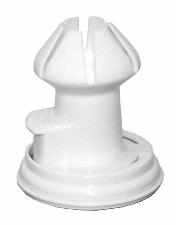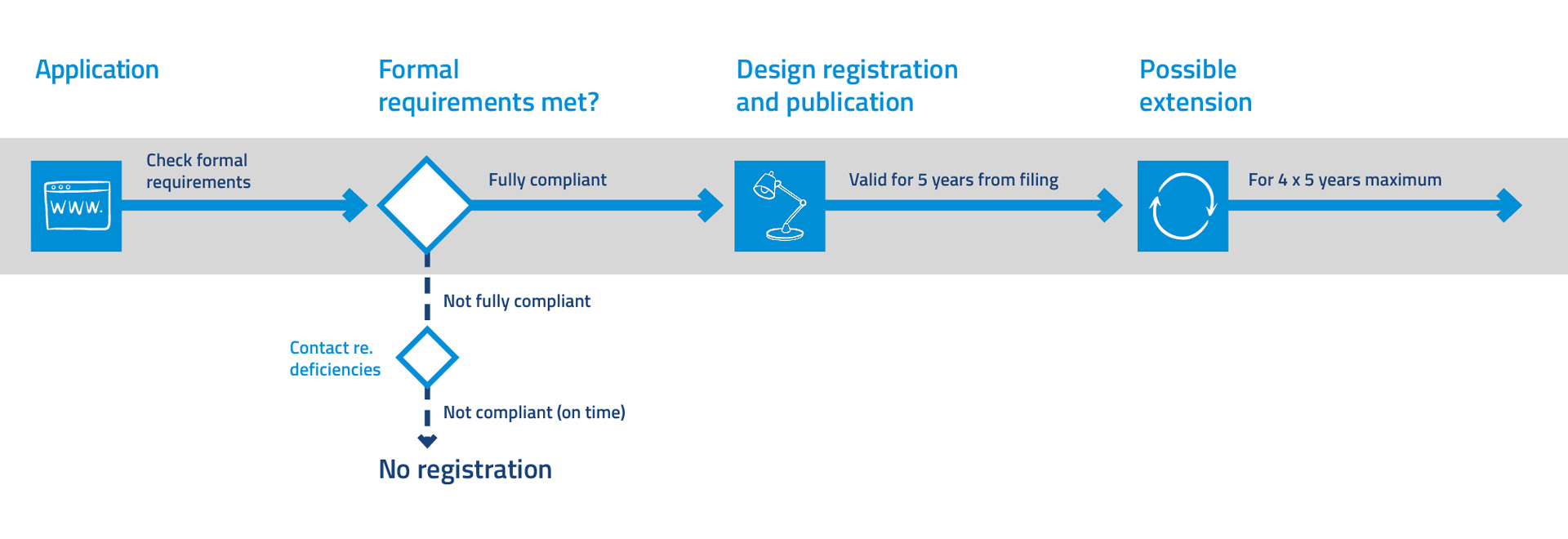A design or drawing relates to the appearance of a product or part of a product, for example a new design for headphones, a watch, coffee-maker, clothing or bag. The design must be novel and have individual character.
The appearance, which is also referred to as the design, results from features such as lines, contours, colours, shape, texture or the materials of the product itself or its ornamentation.
Registering a design
You can protect a design, drawing or a combination of both by registering the design:
 by drawing, we mean a two-dimensional product, for example, the pattern or design on wallpaper, textiles, tiles or crockery.
by drawing, we mean a two-dimensional product, for example, the pattern or design on wallpaper, textiles, tiles or crockery.
 by design, we mean a three-dimensional product, for example, the design of (mobile) telephones, household appliances, lamps, furniture, packaging, building materials, bathroom fittings, toys, crockery or cutlery.
by design, we mean a three-dimensional product, for example, the design of (mobile) telephones, household appliances, lamps, furniture, packaging, building materials, bathroom fittings, toys, crockery or cutlery.
 You can also protect a combination of a drawing and a design, for example, the drawing on a three-dimensional object, such as the decoration on a bag. In such a case, there is a two-dimensional decoration and a three-dimensional shape, and the appearance of the item is defined by both the product (the bag) and by the design (the drawing decorating the bag).
You can also protect a combination of a drawing and a design, for example, the drawing on a three-dimensional object, such as the decoration on a bag. In such a case, there is a two-dimensional decoration and a three-dimensional shape, and the appearance of the item is defined by both the product (the bag) and by the design (the drawing decorating the bag).
In order to claim a design right, it must be novel and have individual character.
Is my design novel?
To qualify for registration, a design must be new. This means that the design must not yet be known to the public. As soon as you publish your design on a website or in an advertising brochure, exhibit it or place it on sale, the design becomes publicly known and therefore is no longer new.
The legal definition of novel
From a legal perspective, in order for a design, or a very similar design, to be novel it must not have been made available to the public before the date on which you applied to register it (filing date) or the date of priority.
Exceptions
- If the design was made available to the public in the twelve months preceding the filing date or the date of priority, that will be disregarded when assessing whether the design is new. This period of grace is allowed. In other words, you are allowed twelve months to apply to register your design after making it available to the public;
- If insiders in the relevant sector in Europe (EU and EEA) could not reasonably have been aware that the design had been made available to the public, that public availability will be disregarded when assessing whether the design is novel. Making a third party aware of a design subject to confidentiality is not considered as 'available to the public'.
If one of these exceptions applies in your case, you must be able to provide proof to that effect.
Does my design have individual character?
A design must have individual character. Basically, that means that your design may not be very similar to one that is already known.
The legal definition of individual character
A design has individual character if the general impression it makes on the informed user differs from the general impression made on that user by designs made available to the public before the date on which you applied to register your design (filing date) or before the date of priority.
Exceptions
- If the design was made available to the public in the twelve months preceding the filing date or the date of priority, that will be disregarded when assessing whether the design has individual character. This period of grace is allowed. In other words, you are allowed twelve months to apply to register your design after making it available to the public;
- If insiders in the relevant sector in Europe (EC and EEA) could not reasonably have been aware that the design had been made available to the public, that public availability will be disregarded when assessing whether the design has individual character. Making a third party aware of a design subject to confidentiality is not considered as 'available to the public'.
If one of these exceptions applies in your case, you must be able to provide proof to that effect.
What does not qualify as a design?
Here are some examples of what cannot be a design:
- In legal terms, a product that is not new or has no individual character is not a design.
- Idea. An idea that has not (yet) been expressed in a tangible form, such as a drawing, prototype or model, cannot be registered as a design. You can, however, record the date on which the idea originated in an i-DEPOT;
- Technical functionality. No design protection is given to the appearance of a product that is exclusively defined by its technical function. Patent law provides this type of protection.
- A design that conflicts with an earlier design, to which exclusive rights have already been granted on the basis of a Community design, a Benelux design, or an international design prior to the filing date or the date of priority of your design application, but which had only been made available to the public after the filing date or date of priority of your design application.
- The design incorporates an older trademark without the permission of the holder of that trademark;
- The design incorporates an existing, copyrighted work, without the permission of the copyright holder.
- The design makes improper use of armorial bearings, flags and other emblems, abbreviations and names of States or international organisations (as provided by Article 6ter of the Paris Convention).
- The design is contrary to public order or morality.
- The characteristic features of the design are insufficiently clear from the application for design registration.
- Design protection for mechanical connectors is excluded in most cases. However, elements of modular systems, such as building blocks for construction toys can, however, be protected as a design.
Example of what does not qualify as a design

The characteristic features of the nozzle of a whipped cream dispenser are solely determined by its technical function, i.e. to dispense nicely piped layers of whipped cream. Therefore, it does not qualify as a design.
Can my application be refused?
Before applying to register a design, it is incumbent upon you to research thoroughly whether your design is new and has individual character. We do not check this for you.
We will process your application if it meets a number of formal requirements. If your application does not meet the formal requirements, we will contact you. It is important that you answer us by the deadlines that we set. If we do not receive your response in due time, your design will not be registered and the costs incurred will not be refunded.
Who can apply for a design registration?
Any person or legal entity can apply to register a design.
As a rule, the applicant is seen as the party entitled to the design rights, even if the application is filed by someone other than the designer or without his consent.
In such a case, the actual designer can claim the application within five years of the date of its publication. The actual designer can also claim that the application and the design rights are invalid on the same basis. There is no deadline to invoke this claim. Any action for vindication or revocation must be initiated before the courts. The action for vindication must be recorded in the Designs Register.
The following rules apply to the designer of a design:
- If the design was designed by an employee in the performance of his duties, the employer is considered to be the designer, unless agreed otherwise.
- If a design was designed to order, unless otherwise agreed in writing, the person who placed the order is considered to be the designer. The design must then, however, be used in trade or industry. If the design is intended exclusively for private purposes, the actual designer remains such in the eyes of the law and the status does not pass to the client (unless agreed otherwise in writing).
It is therefore important to familiarise yourself with the provisions of any contract (or the absence thereof) and, if necessary, to have them amended or supplemented.
When applying to register a design, you can state the name of the actual designer in your application.
Need advice?
BOIP is an independent body and, as such, cannot provide advice on an individual basis. Are you looking for advice on how best to protect your design? An external IP professional can provide assistance.



